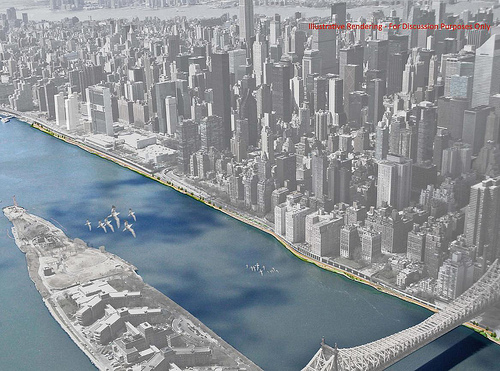
The signing of an agreement to close the East River Greenway gap between 38th Street and 60th Street is big news for people who want to enjoy the waterfront on Manhattan's open space-starved East Side. There's finally a realistic plan in place to build a continuous route to walk, run, or bike along the water. When finished, it could form the backbone of the bike network on the East Side.
But the deal signed this week is an early step in a complicated and lengthy process; construction will take place in three stages and won't wrap up for at least a decade. We checked in with City Council Member Dan Garodnick, a strong supporter of the greenway project, to hear how the process will move forward from here.
Building the full esplanade will cost roughly $200 million. To fund the project, the city turned to a land deal with the United Nations. The City will turn over a piece of the under-used Robert Moses Playground to the United Nations for $70 million and pay for the rest with the proceeds from the sale of One and Two UN Plaza, buildings in which the city owns a stake.
The first $70 million can't pay for the entire greenway, Garodnick explained, meaning work will have to be done in phases. The playground deal will fund an extension of the greenway from 60th Street south to 53rd, where caissons left over from an FDR Drive detour are already in place. That first segment will connect to an existing pedestrian bridge over the highway at 51st Street.
Once the UN buildings have been sold -- which Garodnick said could take some time, depending on the market, since the agreement requires them to go for a high enough price to pay for the construction work -- work could take place on the southern portion of the greenway.
At the same time, work will already be underway on turning the Con Ed pier between 38th Street and 41st Street into a greenway and parkland. Construction on the Con Ed pier should begin soon, according to a press release from the mayor's office. But work on the first new segment of the greenway likely won't start until 2016. At the southern end, work won't begin until roughly 2020.
Moreover, the agreement signed Wednesday is a memorandum of understanding putting the city, state and United Nations on the path to a completed deal; there's still a lot of legal work to be done in addition to design and construction. While this deal clears the way for a continuous off-street cycling route along the East Side, it will be a long while before that connectivity materializes.





